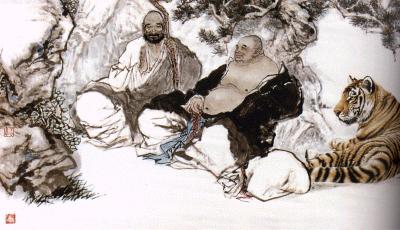Buddhist Psychology
Over 2500 years ago, the Buddha discovered the roots of suffering, and out of this awareness developed an articulate psychology that elegantly describes the human condition. Buddhist psychology tells us that we suffer because we are cut off from aspects of our experience as humans, grasping at pleasure and rejecting pain. And as we engage in this grasping and rejecting, we lose touch with what it feels like to be alive in the moment, cutting ourselves off from the source of true joy.
Rather than experience our emotions directly, allowing them to rise and fall like the waves on the ocean, we wrap them in stories. Instead of feeling anger, we might deny it’s there because we don’t like the experience and we’re afraid of what might happen if we allow ourselves to be angry. Instead of enjoying the happiness of the moment, we hold on to it, afraid of what will happen when it goes away. We identify with our feelings: “I’m an angry person”; “I’m a failure”; “I can’t feel this way because it isn’t me”.
When we deny ourselves the experience of our emotions, we constrict around them, cutting ourselves off from parts of our experience as humans. But tucking those feelings away doesn’t get rid of them; if enough emotions are supressed long enough, they’ll begin to trouble us in a variety of ways, including affecting our relationships, causing anxiety and depression, and even filling our minds with obsessive, troubling thoughts.
But there is a way out of this cycle of grapsing and rejecting, and that is to begin, gently, to notice and name what we’re experiencing in the moment. It may start with just naming one’s sense that something doesn’t quite feel right. It continues with noticing and naming our emotions, including what we experience in our bodies as the emotions pass through. It involves dis-identifying from our emotions, which doesn’t mean we deny our experience of them. On the contrary, we allow ourselves to feel our emotions fully, but remember that we are people who experience the feelings, we aren’t the feelings themselves.
Although meditation is the primary method for engaging in noticing and naming our experiences, we can practice moments of mindfulness throughout the day by pausing and asking ourselves, “what am I noticing right now?”. For many of us, that’s all we’re able to do at first. People who are experiencing strong emotions or have a history of trauma may need the support of therapy before they are able to fully engage in mindfulness practices.
The use of mindfulness practices in psychotherapy is proving to be a highly effective way to help people uncover aspects of their experiences that have been supressed from awareness. Because these practices focus on the present moment, they work well in conjunction with humanistic and existential psychologies.
© 2004 by Anne Ihnen
Buddhist and Western psychology
A Buddhist approach to psychotherapy
An unusual silence
Buddhism and Cognitivism
Buddhism and Science
Buddhism
Soul of Compassion
Buddhism as a psychotherapy
Buddhist psychology
Buddhist psychology
Buddhist meditation and depth psychology
Increasing use of Buddhist Practices in Psychotherapy
Lama Yeshe on Buddhist psychology
Meditation and psychotherapy
Philosophy and Psychology in the Abhidharma
Psychology as a function of culture
Abhidharma in daily life
Awakening the Heart
Therapy and Meditation
Buddha on Compassion
Spirituality and Western Psychology
Buddhism: A Modern Perspective
Buddhism as a religion, philosophy, psychology and a science
Buddhist psychology: A review of theory and practice
Contemplative Eye:
Cosmology and meditation
Have Map, Can Unravel
I equals Awareness
Is Buddhism Good for Your Health?
Love in Buddhist Bioethics
Mindfulness of Ourselves, Mindfulness of Others
On avoiding and embracing our pain
Psychology, Physiology, and Cosmology
The Abhidhamma Philosophy
The Psychology of Meditation
Wisdom and Compassion: Buddhist Psychotherapy as Skillful Means


